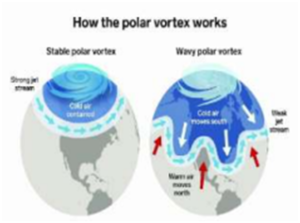Ethics Theory, TLP-UPSC Mains Answer Writing
Q. 2. What is the Polar Vortex? Explain its role in influencing extreme weather patterns in the mid-latitudes. (150 words, 10 marks)
Introduction
The Polar Vortex is a large, low-pressure, cyclonic circulation of cold air located near the Earth’s poles in the stratosphere. It plays a crucial role in modulating weather patterns, especially in mid-latitudes.
Body
Characteristics of the Polar Vortex
- Location and structure: Centered around the Arctic and Antarctic, it exists in both the troposphere and stratosphere, more stable in the latter.
- Seasonal behavior: It strengthens during winter and weakens or breaks apart in summer.
- Wind direction: It circulates counterclockwise in the Northern Hemisphere and confines frigid air near the poles.
- Temperature gradient driver: Formed by the steep temperature difference between the polar and mid-latitude regions.

Role in influencing extreme weather
- Sudden Stratospheric Warming (SSW): Disruption of the vortex causes warm air to rise and displace cold air southward, leading to cold waves in North America and Eurasia.
- Jet stream disturbance: A weakened vortex causes the jet stream to meander, bringing prolonged cold spells, storms, or heatwaves to mid-latitudes.
- Increased snowfall events: Displaced polar air meets moist systems, increasing chances of heavy snow, as seen in the US blizzards of 2021.
- Blocking patterns: Vortex disruption can lead to atmospheric blocking, trapping weather systems and causing prolonged droughts or floods.
- Temperature extremes: Both cold snaps and unseasonal warm spells in temperate zones can arise due to the vortex-induced jet stream fluctuations.
Conclusion
The Polar Vortex is a key player in global climate dynamics. Its weakening, often linked to Arctic amplification, leads to erratic mid-latitude weather. Monitoring its behavior is essential for accurate seasonal forecasting and disaster preparedness.













